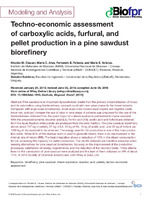Techno‐economic assessment of carboxylic acids, furfural, and pellet production in a pine sawdust biorefinery
Date
2018-08-19Author
Clauser, Nicolás Martín
Gutiérrez, Leticia Soledad
Area, María Cristina
Felissia, Fernando Esteban
Vallejos, María Evangelina
Metadata
Show full item recordAbstract
Pine sawdust is an important lignocellulosic waste from the primary industrialization of wood, and its valorization using the biorefinery concept could add new value chains to the forest industry. Compared with large‐scale biorefineries, small‐scale ones involve lower capital and logistics costs, lower risk, and can increase the use of labor in rural areas. A scheme was proposed for the use of the hemicelluloses obtained from the spent liquor of a steam explosion pretreatment of pine sawdust. With the proposed scheme, levulinic acid (LA), formic acid (FA), acetic acid and furfural are obtained from the liquid fraction while pellets are produced from the solid fraction. This pine sawdust biorefinery allows about 747 kg of pellets, 57 kg of LA, 23 kg of FA, 18 kg of acetic acid, and 22 kg of furfural per 1000 kg of dry sawdust to be obtained. The energy used for LA production is one of the main production costs. When 95% of the residual solid is used to generate steam, there is an improvement in the internal rate of return (IRR). The heat integration allows a reduction of 10% in the steam consumption for LA, increasing the capacity for pellet production. The results obtained are therefore essential when seeking alternatives for pine sawdust biorefineries, focusing on the improvement of the production processes, satisfaction of energy requirements, and the reduction of the recovery costs. Three alternatives for the valorization of pine sawdust were analyzed and the best of them obtained an IRR of about 17%.
Collections
The following license files are associated with this item:




